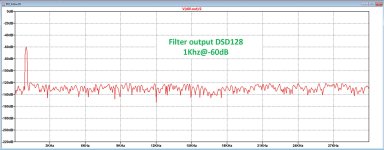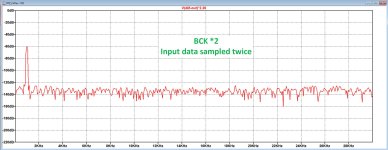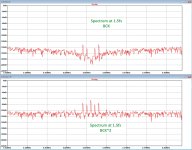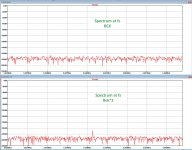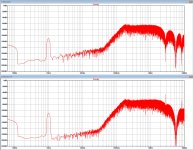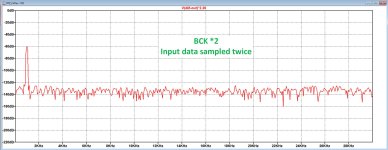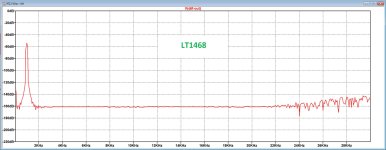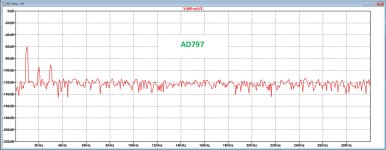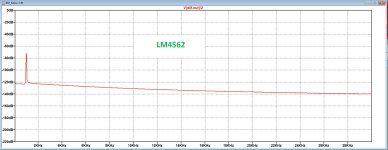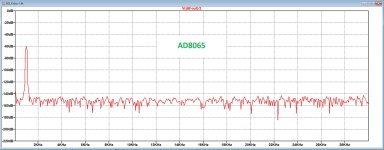What I do here is use one modest linear +5v power supply which is shared by the clean side of I2SoverUSB and by PCM2DSD. They both have their own secondary voltage regulators and they are both going to be on the same ground anyway. An LM7805 or something like that would be good enough. That said, I would isolate and reclock after PCM2DSD using external clocking, so the shared power supply should have little or no effect on final SQ anyway.A question for those who have experimented with PSs. Which of the following is more likely to have a noticeable impact on the sound quality of this DAC; using a low noise power supply on the Reclock side of the i2soverUSB or on the PCM2DSD ? Replying “both” will not answer the question I’ve asked 😉. Any thoughts?
I suggest you also include a HQPlayer quasi-multibit modulator (e.g. AMSDM7 512+fs) as a reference to your listening evaluation as such modulator has been shown to work well with this dac.I have the free version of HQplayer but unfortunately it doesn’t work with Amazon , it’s no problem to download a file though and use HQplayer .
HQ Player has a choice of upsampling filters and of modulators. The sound you get is dependent on both factors. Just to specify one factor does not fully specify the resulting sound. Trying AMSDM7 512+fs with a variety of filters may give some idea of what is attributable to the modulator itself.
@ThorstenL : I have been taking a brief look on some of the 74 types you mentioned in #2984 and #2982 and one of the differences I notice is that the inductances of the pins of the various packages vary quite a lot. And here your 74ALVC164245 IC appears to have a comparatively very balanced pin inductance which I reckon would be a feasible quality in this FIRDAC context ... 
And then, regarding clock adjustment I noticed that you would prefer to use a 1/100 division probe or an active probe. Would you happen to have a suggestion for an active probe that is accessible price-wise and works with BNC connectors? Would something like this work:
https://www.ebay.de/itm/33524613908...Kw9yld7MB7JhuM7saSfITAQQ==|tkp:Bk9SR-DL47fkYw
And, to this end, would you say that a 200 MHz oscilloscope would be sufficient for such a measurement?
Also, since you appear to be well-versed in various IC packages maybe I can ask you for a bit of advice on this: I am for comparison considering a basic R2R DAC. Would you happen to have a suggestion for an IC version that would be suitable for such a DAC? I am considering the 74LCX series as it should have balanced P/N outputs ... Do you think that would be the best choice for an R2R DAC?
And then, just for clarification and FYI ... I feel like mentioning that we may have different tastes in music as I am mostly into classical music ...
@MarcelvdG : This design keeps simmering in my mind and I hope I can ask you a couple of questions in relation to something you have said previously ...
1. In a previous post (I couldn't find exactly where) you mention that inter-IC die variations may be larger than intra-IC die variations. Would you happen to be able to say how large these variations typically are and on which parameters of the ICs?
I have recently measured Ron on a couple of 74NC7SZ374 and 74AUP1G374s and at least for static conditions their P & N resistances are exactly the same (within my fluke multimeter's resolution). However, since the measured ICs were bought as part of the same order I suppose that they likely would be part of the same production batch and thus might have more identical specs ... Even with physically separate logic ICs wouldn't intra-batch ICs have (much) more identical specs than ICs coming from different batches?
2. In #2812 you say that:
It made me wonder to what extent timing differences between the various gates may also produce intermodulation/distortion products that are of the same magnitude? ... I remember quoting a bit of TI forum information in #1922 stating that:
Would it make sense to e.g. assess how much the IMD magnitude of e.g. a 50 ps difference in gate timing would produce ...??
Please comment as it is feasible to you ... For one thing I admittedly have no idea if this entails meter-long formulas to calculate
Cheers & have a fine day,
Jesper

And then, regarding clock adjustment I noticed that you would prefer to use a 1/100 division probe or an active probe. Would you happen to have a suggestion for an active probe that is accessible price-wise and works with BNC connectors? Would something like this work:
https://www.ebay.de/itm/33524613908...Kw9yld7MB7JhuM7saSfITAQQ==|tkp:Bk9SR-DL47fkYw
And, to this end, would you say that a 200 MHz oscilloscope would be sufficient for such a measurement?
Also, since you appear to be well-versed in various IC packages maybe I can ask you for a bit of advice on this: I am for comparison considering a basic R2R DAC. Would you happen to have a suggestion for an IC version that would be suitable for such a DAC? I am considering the 74LCX series as it should have balanced P/N outputs ... Do you think that would be the best choice for an R2R DAC?
And then, just for clarification and FYI ... I feel like mentioning that we may have different tastes in music as I am mostly into classical music ...
@MarcelvdG : This design keeps simmering in my mind and I hope I can ask you a couple of questions in relation to something you have said previously ...
1. In a previous post (I couldn't find exactly where) you mention that inter-IC die variations may be larger than intra-IC die variations. Would you happen to be able to say how large these variations typically are and on which parameters of the ICs?
I have recently measured Ron on a couple of 74NC7SZ374 and 74AUP1G374s and at least for static conditions their P & N resistances are exactly the same (within my fluke multimeter's resolution). However, since the measured ICs were bought as part of the same order I suppose that they likely would be part of the same production batch and thus might have more identical specs ... Even with physically separate logic ICs wouldn't intra-batch ICs have (much) more identical specs than ICs coming from different batches?
2. In #2812 you say that:
The plot in post #2696 shows that a +/- 1 ppm change of the bit weight depending on the previous bit is enough to produce about the same intermodulation products in the audio band as the present DAC and filter do.
It made me wonder to what extent timing differences between the various gates may also produce intermodulation/distortion products that are of the same magnitude? ... I remember quoting a bit of TI forum information in #1922 stating that:
And according to a post in TI's EE forum they expect CMOS ICs inter-gate skew to be less than 250 ps although this is not guaranteed.
Would it make sense to e.g. assess how much the IMD magnitude of e.g. a 50 ps difference in gate timing would produce ...??
Please comment as it is feasible to you ... For one thing I admittedly have no idea if this entails meter-long formulas to calculate

Cheers & have a fine day,
Jesper
1. Basically on all parameters, but I have too little information to give a quantitative answer to your questions about matching on a chip and within the same batch.
The only data I have about matching on one chip of standard logic ICs are in this thread, which won't help much: https://www.diyaudio.com/community/...eap-fet-differential-pair.228957/post-3347847
You can get an impression of the differences between chips of different batches by looking at minimum, typical and maximum datasheet values for a given temperature and supply voltage. The values are generally conservative to keep the yield loss small, like +/- 4 sigma to +/- 6 sigma values of a normally distributed parameter.
It will be considerably better within one batch, but only the people doing production testing know how much better. Chips at the edge of a wafer usually differ more from their colleagues than those that are not near the edge.
It will be better yet on one chip, but I can't tell you by how much. It depends very much on the process and layout.
2. Suppose you play DSD256, which has an 88.5771 ns bit time. When the RTZ pulses are half that, they are 44.2885 ns wide. A 1 ppm error then corresponds to 44.2885 fs.
That is, when the pulse widths coming out of all FIRDAC taps change in the same direction by +/- 44.2885 fs depending on the previous bit value, that produces about the same low-level distortion as bohrok2610 has measured (and that appears to be filter-dominated).
What matters are pulse width changes depending on other data bits. If one tap systematically produces 50 ps wider pulses than the others, no matter what the previous bit was, it just reduces the stopband suppression of the FIRDAC.
The only data I have about matching on one chip of standard logic ICs are in this thread, which won't help much: https://www.diyaudio.com/community/...eap-fet-differential-pair.228957/post-3347847
You can get an impression of the differences between chips of different batches by looking at minimum, typical and maximum datasheet values for a given temperature and supply voltage. The values are generally conservative to keep the yield loss small, like +/- 4 sigma to +/- 6 sigma values of a normally distributed parameter.
It will be considerably better within one batch, but only the people doing production testing know how much better. Chips at the edge of a wafer usually differ more from their colleagues than those that are not near the edge.
It will be better yet on one chip, but I can't tell you by how much. It depends very much on the process and layout.
2. Suppose you play DSD256, which has an 88.5771 ns bit time. When the RTZ pulses are half that, they are 44.2885 ns wide. A 1 ppm error then corresponds to 44.2885 fs.
That is, when the pulse widths coming out of all FIRDAC taps change in the same direction by +/- 44.2885 fs depending on the previous bit value, that produces about the same low-level distortion as bohrok2610 has measured (and that appears to be filter-dominated).
What matters are pulse width changes depending on other data bits. If one tap systematically produces 50 ps wider pulses than the others, no matter what the previous bit was, it just reduces the stopband suppression of the FIRDAC.
Since it seemed not possible with LTSpice to simulate the odd spectral lines caused by HF modulation when playing low level signals, Marcel suggested to look at the Firdac’s summing point with the original OPA2210 filter module attached, instead of looking at the filter’s output signal.
And also to possibly make the cause of the problem even more clear to double the speed of the whole RTZ Firdac and sample each original DSD128 sample twice
The spectrum of an unloaded summing point, as well as a summing point loaded with a LC filter’s of several orders, starting either with Cap or Inductor, all simulated to the same 105dB S/N up to 20Khz, perfectly corresponding to real life measurements, so this seems to be a reliable simulation result.
I tried 18Mhz OPA2210's and LT1468's op-amps, the latter being a 5nV/rtHz low noise op-amp with a 90Mhz GBW, and for both cases the S/N came out correctly with the right S/N.
And although the 18Mhz OPA2210 model performed, it could be that LT1468 is be a better choice for the first stage to suppress the odd spectral lines because of its higher BW.
Setup
Since at the Firdac’s summing point there was no real difference visible between the spectra loaded with the OPA2210 or the LT1468 filter, only one set has been attached from resp. the spectrum zoomed in to 10Mhz, and the even further zoomed in spectra at 0.5fs, fs and 1.5fs.
Attachment 1, Spectrum up to 30Khz after the OPA2210 filter, confirming the correct functioning of the simulation model.
Attachment 2, Time Spectra at the Firdacs summing point.
Upper image part driven with BCK , lower part with double BCK repeating each input sampled twice.
See the high level spectral lines around 0.5fs and 1.5fs in the lower image, far above the above the same spectral lines when using the original BCK since its attenuation at the fs/2 is no longer there.
Attachment 3, Zoomed in at the spectrum around the original 0.5fs
Attachment 4, zoomed in around the original fs
Attachment 5, zoomed in around the original 1,5fs.
In any case, the idea of lifting the spectral lines by sampling the input data twice with a clock at twice the original BCK, made the spectral lines 0.5fs and 1.5fs raise by 60 to 70 dB, as visible in the attachments 3 and 5.
But now looking at the filtered spectrum, the filter with op-amps gave crazy results maybe because of overloading its input, that's why I used a 4th order LC filter instead.
With this filter no signs of modulation products are visible, see sixth attachment.
So in this case LTSpice doesn't have the right op-amp models to replicate what's happening in real life when huge amounts of HF are added to the signal.
Hans
And also to possibly make the cause of the problem even more clear to double the speed of the whole RTZ Firdac and sample each original DSD128 sample twice
The spectrum of an unloaded summing point, as well as a summing point loaded with a LC filter’s of several orders, starting either with Cap or Inductor, all simulated to the same 105dB S/N up to 20Khz, perfectly corresponding to real life measurements, so this seems to be a reliable simulation result.
I tried 18Mhz OPA2210's and LT1468's op-amps, the latter being a 5nV/rtHz low noise op-amp with a 90Mhz GBW, and for both cases the S/N came out correctly with the right S/N.
And although the 18Mhz OPA2210 model performed, it could be that LT1468 is be a better choice for the first stage to suppress the odd spectral lines because of its higher BW.
Setup
- For this specific set of simulations I used 2 different loadings at the Firdac’s summing point,
1) the original filter with 18Mhz OPA2210 and 2) same filter with 90Mhz LT1468 - File used was a 1Khz@-60dB .dsf file as provided by Bohrok.
- Simulation time window was 16msec giving a 62.5Hz bin width.
- Signal was sampled in all cases with a 2^24 point FFT, giving a 500Mhz BW to prevent as much as possible aliases polluting the signal in the band of interest
Since at the Firdac’s summing point there was no real difference visible between the spectra loaded with the OPA2210 or the LT1468 filter, only one set has been attached from resp. the spectrum zoomed in to 10Mhz, and the even further zoomed in spectra at 0.5fs, fs and 1.5fs.
Attachment 1, Spectrum up to 30Khz after the OPA2210 filter, confirming the correct functioning of the simulation model.
Attachment 2, Time Spectra at the Firdacs summing point.
Upper image part driven with BCK , lower part with double BCK repeating each input sampled twice.
See the high level spectral lines around 0.5fs and 1.5fs in the lower image, far above the above the same spectral lines when using the original BCK since its attenuation at the fs/2 is no longer there.
Attachment 3, Zoomed in at the spectrum around the original 0.5fs
Attachment 4, zoomed in around the original fs
Attachment 5, zoomed in around the original 1,5fs.
In any case, the idea of lifting the spectral lines by sampling the input data twice with a clock at twice the original BCK, made the spectral lines 0.5fs and 1.5fs raise by 60 to 70 dB, as visible in the attachments 3 and 5.
But now looking at the filtered spectrum, the filter with op-amps gave crazy results maybe because of overloading its input, that's why I used a 4th order LC filter instead.
With this filter no signs of modulation products are visible, see sixth attachment.
So in this case LTSpice doesn't have the right op-amp models to replicate what's happening in real life when huge amounts of HF are added to the signal.
Hans
Attachments
@gentlevoice
Some scope probe possibilities:
https://jahonen.kapsi.fi/Electronics/DIY 1k probe/
https://www.sigcon.com/Pubs/straight/probes.htm
https://hackaday.io/project/184924-diy-13-ghz-fet-probe
Regarding 200MHz scopes and, say, an 11MHz BCLK, square waves consist of odd harmonics, and you probably would want to see at least the first 2 harmonics, which would be the 3rd and the 5th, at 33MHz and 55MHz respectively. So, you ought to be able to see a reasonably square looking wave (plus or minus the normal scope distortion spec of course).
Regarding measuring risetime accurately, that would be another matter since it could be around 1ns or less. https://www.tek.com/en/support/faqs/how-bandwidth-related-rise-time-oscilloscopes
Some scope probe possibilities:
https://jahonen.kapsi.fi/Electronics/DIY 1k probe/
https://www.sigcon.com/Pubs/straight/probes.htm
https://hackaday.io/project/184924-diy-13-ghz-fet-probe
Regarding 200MHz scopes and, say, an 11MHz BCLK, square waves consist of odd harmonics, and you probably would want to see at least the first 2 harmonics, which would be the 3rd and the 5th, at 33MHz and 55MHz respectively. So, you ought to be able to see a reasonably square looking wave (plus or minus the normal scope distortion spec of course).
Regarding measuring risetime accurately, that would be another matter since it could be around 1ns or less. https://www.tek.com/en/support/faqs/how-bandwidth-related-rise-time-oscilloscopes
Last edited:
In any case, the idea of lifting the spectral lines by sampling the input data twice with a clock at twice the original BCK, made the spectral lines 0.5fs and 1.5fs raise by 60 to 70 dB, as visible in the attachments 3 and 5.
But now looking at the filtered spectrum, the filter with op-amps gave crazy results maybe because of overloading its input, that's why I used a 4th order LC filter instead.
With this filter no signs of modulation products are visible, see sixth attachment.
An LC filter made of ideal components is linear and time invariant, so it cannot create intermodulation components. That's as expected.
I'm curious what your crazy spectrum at the output of the op-amp filter looks like. With 60 dB larger spectral lines around fs/2 and its odd multiples at the summing points, second order intermodulation products at the op-amp outputs should increase by 120 dB if nothing clips (to be more precise, if the second-order term still dominates). It is very well possible that the distortion gets larger than the intended signal.
By the way, using the normal clocking but changing the value of one FIRDAC resistor a bit (such that it doesn't match the others anymore) could be a way to increase the stuff around fs/2 by less than 50 dB ... 70 dB.
Last edited:
@MarcelvdG : Thanks again, Marcel, for your feedback 
When reading your comments on the intra- vs inter-die variations I read that there are many factors involved, and I assume, some of the data involved are also not publicly available ... "company intrinsic know-how". So, although there may be some variation, I reckon that actual measurements of randomly selected items from an order may give an indication of the variability of the ICs in question.
Interesting ... I reckon this is (one of the) reason(s) why you have taken such efforts to outbalance the influences of the various outputs on the LV574s ... ? To this end: Did you notice the inductance values of the IC that ThorstenL linked to, the 74ALVC164245? At least in the BGA versions the inductances are very closely matched (IBIS model at the bottom ... & could of course be that this is a BGA trait):
https://www.ti.com/product/SN74ALVC164245#design-development
@Markw4 : Thanks Mark for chiming in on this and the links. Besides being intriguingly simple - the 1 kohm versions - it also made me think of my own setup where the oscilloscope input impedance is 1 Mohm//12pF and thus not 50 ohms. Saying this because I do experience some visual overshoots that I would not expect to be there and am thinking that maybe it would be a good idea to make it a 50 ohm termination - at least for these high frequency signals.
Regarding the oscilloscope bandwidth the rise time is 1.75ns (specifications sheet, 10% to 90%) so I suppose it is quite high relative to the rise times of the clock ICs ... Could be it would be more feasible to mount a TC42 trimmer on top of the clock series resistor and then listen to what resistor value sounds best .. A thing to consider ...
Thanks again both of you
Jesper
It will be considerably better within one batch, but only the people doing production testing know how much better. Chips at the edge of a wafer usually differ more from their colleagues than those that are not near the edge.
When reading your comments on the intra- vs inter-die variations I read that there are many factors involved, and I assume, some of the data involved are also not publicly available ... "company intrinsic know-how". So, although there may be some variation, I reckon that actual measurements of randomly selected items from an order may give an indication of the variability of the ICs in question.
What matters are pulse width changes depending on other data bits.
Interesting ... I reckon this is (one of the) reason(s) why you have taken such efforts to outbalance the influences of the various outputs on the LV574s ... ? To this end: Did you notice the inductance values of the IC that ThorstenL linked to, the 74ALVC164245? At least in the BGA versions the inductances are very closely matched (IBIS model at the bottom ... & could of course be that this is a BGA trait):
https://www.ti.com/product/SN74ALVC164245#design-development
@Markw4 : Thanks Mark for chiming in on this and the links. Besides being intriguingly simple - the 1 kohm versions - it also made me think of my own setup where the oscilloscope input impedance is 1 Mohm//12pF and thus not 50 ohms. Saying this because I do experience some visual overshoots that I would not expect to be there and am thinking that maybe it would be a good idea to make it a 50 ohm termination - at least for these high frequency signals.
Regarding the oscilloscope bandwidth the rise time is 1.75ns (specifications sheet, 10% to 90%) so I suppose it is quite high relative to the rise times of the clock ICs ... Could be it would be more feasible to mount a TC42 trimmer on top of the clock series resistor and then listen to what resistor value sounds best .. A thing to consider ...
Thanks again both of you
Jesper
The 4th order LC Filter was used as the refence to prove that the whole setup worked properly.An LC filter made of ideal components is linear and time invariant, so it cannot create intermodulation components. That's as expected.
I'm curious what your crazy spectrum at the output of the op-amp filter looks like. With 60 dB larger spectral lines around fs/2 and its odd multiples at the summing points, second order intermodulation products at the op-amp outputs should increase by 120 dB if nothing clips (to be more precise, if the second-order term still dominates). It is very well possible that the distortion gets larger than the intended signal.
By the way, using the normal clocking but changing the value of one FIRDAC resistor a bit (such that it doesn't match the others anymore) could be a way to increase the stuff around fs/2 by less than 50 dB ... 70 dB.
Here repeated again as reference in Attachment 1.
Same setting as before, 500Mhz FFT BW, DSD128 sampled twice with a 11.29Mhz clock.
I used several op-amp in the original RTZ Firdac MFB filter.
OPA2210
LT1468, very fast low noise
AD797, also very fast
LM4562, according to Syn08 as the most correct implemented Spice model so far
OPA1656, a fast low noise Fet opamp
AD8065, also a very fast low noise Fet op-amp.
The OPA2210 and the OPA1656 kept hanging during the simulation, even after being restarted a few times without any result.
The LT1468 gave a spectrum without any credibility.
The AD797 came through with ca 6dB too much noise in the audio band and with odd unexpected H2 and H3 distortion levels.
LM4562 performed somewhat similar to the LT1468 with a spectrum that's far off
AD8065 looks nice but with a noise level at ca -150dB which is 20dB too low.
So not one of them gave the same result as the referenced LC filter.
That's what made me conclude in my previous posting, that this test is one bridge too far for simulating Marcel's MFB filter in LTSpice.
Getting these results took several days in full time simulations.
Hans
Attachments
Transient simulations do not normally include analogue circuit noise; some simulators have a transient noise feature, but it is usually off by default, because it slows down everything substantially. I think numerical errors and aliases just happen to have about the same level in some of your simulations as analogue noise has in reality.
The AD797 result looks quite reasonable when you take into account that the noise floor is not representative and that the distortion products will be much smaller with the normal FIRDAC clock. The other op-amps either don't converge or don't distort at all; is distortion even modelled for the latter group?
The AD797 result looks quite reasonable when you take into account that the noise floor is not representative and that the distortion products will be much smaller with the normal FIRDAC clock. The other op-amps either don't converge or don't distort at all; is distortion even modelled for the latter group?
I have been taking a brief look on some of the 74 types you mentioned in #2984 and #2982 and one of the differences I notice is that the inductances of the pins of the various packages vary quite a lot.
Of course. I think TSSOP or TVSOP are acceptable in practice. BGA seems unnecessary difficult to process, even in commercial volume production. Using a "middle of the road" PCBA contractor in the far east with BGA (XMOS) the yield was at around 70%. on small PCB's with a single BGA package.
And here your 74ALVC164245 IC appears to have a comparatively very balanced pin inductance which I reckon would be a feasible quality in this FIRDAC context ...
The 74LVC16374 which is the one to use for shift registers with 74ALVC164245 used as actual bit switch for a FIR DAC also has a low inductance and balanced layout.
And then, regarding clock adjustment I noticed that you would prefer to use a 1/100 division probe or an active probe. Would you happen to have a suggestion for an active probe that is accessible price-wise and works with BNC connectors?
When I needed one, I made my own, differential. Validated on 5GHz RF generator/analyser.
Stuff worth using was either ridiculous cost, or old 2nd hand.
Would something like this work:
No idea.
And, to this end, would you say that a 200 MHz oscilloscope would be sufficient for such a measurement?
I used a rigol DSO rated at 300MHz analogue bandwidth with 2GS/s.
Also, since you appear to be well-versed in various IC packages maybe I can ask you for a bit of advice on this: I am for comparison considering a basic R2R DAC. Would you happen to have a suggestion for an IC version that would be suitable for such a DAC?
No. The reason is that such a DAC simply is not doable in any sensible way.
IF (big if) I were to try this, it would obviously balanced.
I would use 16-32 bit in "thermometer code DAC" for the MSB's, using "error scrambling" with a high oversampling factor. This gives 16 or 32 levels or 4 - 5 Bit's without any MSB Trim and should allow the MSB's of a R2R DAC to operate better than any actual R2R structure.
As we will struggle with an R2R structure that is accurate to more than 12 Bit. Combining it with (say) 4 Bit of thermometer code gives 16 Bit resolution in hardware using (say) 28 FPGA Pin's per channel followed by suitable latches.
Any bit's below bit 16 would use DS Modulation. As we have we have 4 latches and pin's to spare (they usually come in multiples of 8 or 16) we can use a 4-bit modulator with relatively low order to cover bit 17...32.
Now, this is a major FPGA and Hardware project, I'm not sure I'm ready to undertake solo.
If I wanted a Multibit DAC that does more than a TDA1541 can, use this:
http://www.ti.com/product/DAC11001A
https://www.analog.com/en/products/ad5791.html
https://th.mouser.com/c/semiconduct...l-to-analog-converters-dac/?resolution=20 bit
And then, just for clarification and FYI ... I feel like mentioning that we may have different tastes in music as I am mostly into classical music ...
I listen to a wide range of music, classical included.
Thor
The other op-amps either don't converge or don't distort at all; is distortion even modelled for the latter group?
Op-Amp models are very variable. Most are not device level. More recent models do model more internal non-linearities but they are not commonly available on free spice, but at cost.
Thor
@ThorstenL : Hmmm... thanks for considering and replying.
Regarding an R2R DAC as I mentioned I am thinking about a basic R2R DAC - the idea is to just get an idea about the R2R DAC sound relative to the DSD sound. With this in mind I would not venture into anything costly or complex or involving an IC R2R DAC solution.
Not really knowledgeable in the manufacturing field but what you say sounds sensible. I have not yet tried BGAs so no practical experiences here - looks like a somewhat different manufacturing approach though ...
Yup, sounds like a fine way of doing it ... Have been considering it a couple of times (i.e. validating e.g. a probe like the one I linked to) but unfortunately I don't have access to equipment that would be able to make such a validation. Well, that's just the way it currently is ...
Again, thanks for your feedback ...
Cheers, Jesper
Regarding an R2R DAC as I mentioned I am thinking about a basic R2R DAC - the idea is to just get an idea about the R2R DAC sound relative to the DSD sound. With this in mind I would not venture into anything costly or complex or involving an IC R2R DAC solution.
Of course. I think TSSOP or TVSOP are acceptable in practice. BGA seems unnecessary difficult to process, even in commercial volume production.
Not really knowledgeable in the manufacturing field but what you say sounds sensible. I have not yet tried BGAs so no practical experiences here - looks like a somewhat different manufacturing approach though ...
When I needed one, I made my own, differential. Validated on 5GHz RF generator/analyser.
Yup, sounds like a fine way of doing it ... Have been considering it a couple of times (i.e. validating e.g. a probe like the one I linked to) but unfortunately I don't have access to equipment that would be able to make such a validation. Well, that's just the way it currently is ...
Again, thanks for your feedback ...
Cheers, Jesper
Regarding R2R dacs, typically they are segmented with the first few most significant bits being thermometer coded, and with the lower order bits being R2R. As it happens Andrea Mori makes such a dac. Have one here, in fact. Of course comparisons between Andrea's R2R and DSD dacs have been done here and in Italy. So, I can tell you what subjective differences have been reported from the two groups, here and in Italy. However if nothing will do but to build your own, then guess I can't help.
Last edited:
Regarding an R2R DAC as I mentioned I am thinking about a basic R2R DAC - the idea is to just get an idea about the R2R DAC sound relative to the DSD sound.
Get a second hand unit with a good R2R DAC Chip(set). There are CD-Players and older DAC's that you can now get for a song and a dance. I recently lost out to someone else on a Nakamichi Car Audio DAC with dual differential TDA1541, the final price was still under 50 Bux.
With this in mind I would not venture into anything costly or complex or involving an IC R2R DAC solution.
Then don't bother. A badly done R2R is worse than a well done DS.
Thor
Regarding R2R dacs, typically they are segmented with the first few most significant bits being thermometer coded, and with the lower order bits being R2R. As it happens Andrea Mori makes such a dac. Have one here, in fact. Of course comparisons between Andrea's R2R and DSD dacs have been done here and in Italy. So, I can tell you what subjective differences have been reported from the two groups, here and in Italy. However if nothing will do but to build your own, then guess I can't help.
Pray tell...
Thor
- Home
- Source & Line
- Digital Line Level
- Return-to-zero shift register FIRDAC
